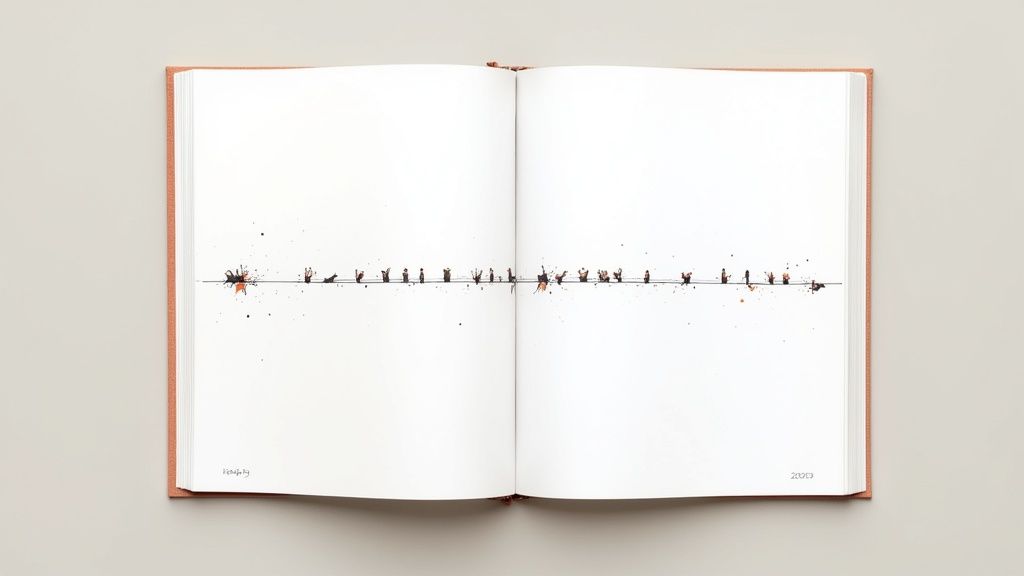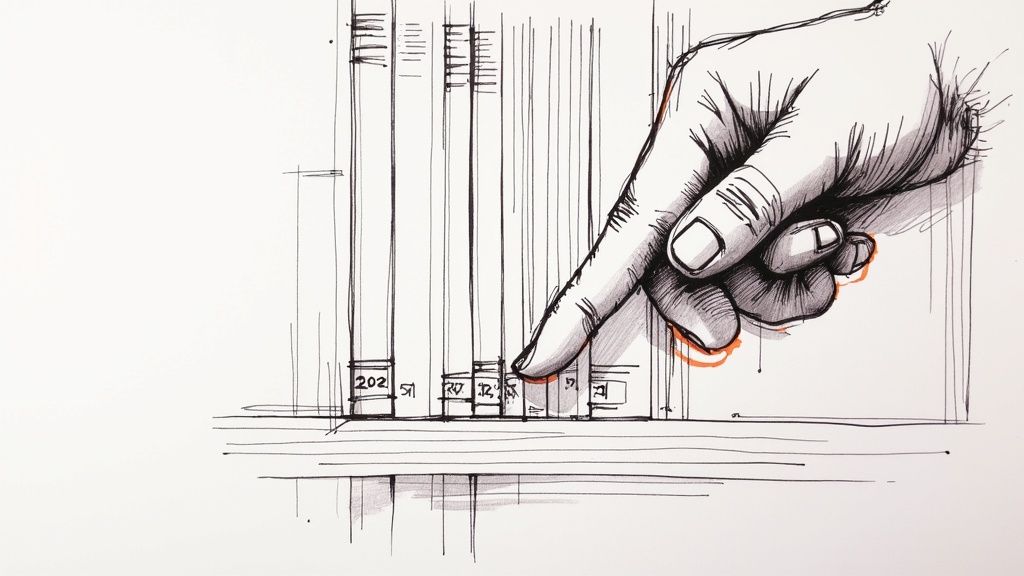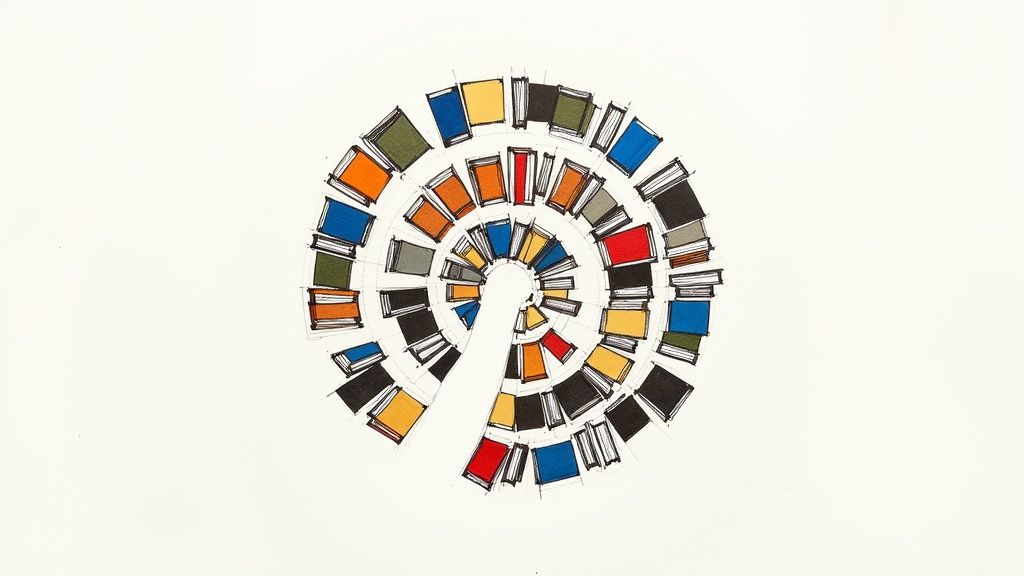So you've decided to tackle a massive book series. Awesome. But right at the start, you hit a classic crossroads: do you read in chronological order, following the story's internal timeline, or do you stick with the publication order, the way the author originally released the books?
This isn't just a nerdy debate—it’s a choice that completely changes how you experience a new world. Think of it like watching a film franchise with prequels. Each path offers a totally different adventure.
Why Your Reading Order Matters

Jumping into a long-running series can feel like tuning into a TV show halfway through season three. You don't know the characters' backstories, you've missed key events everyone keeps referencing, and you're constantly playing catch-up. The reading order you choose is your roadmap through that narrative landscape.
This decision is more than just a matter of taste. It directly impacts how you uncover major plot twists, watch characters grow, and see the world take shape. Picking a reading order is the very first step to truly immersing yourself in a new literary universe.
The Core Reader Debate
The big question really comes down to a conflict between two perfectly good approaches: the story's timeline versus the author's original intent. Each one gives you a unique lens to view the story through, and which one is "better" depends entirely on what you're looking for.
Chronological Order: This path lines up the books according to the in-world timeline. You see everything as it happened, from the earliest prequel right through to the final book. It creates a smooth, linear story from start to finish.
Publication Order: This means you read the books in the sequence they hit the shelves. You experience the story exactly as the author unveiled it to the public, preserving all the original surprises and watching the writer's style evolve over time.
For example, let's look at The Chronicles of Narnia. Reading chronologically means starting with The Magician's Nephew, which explains how Narnia was created. But reading in publication order means starting with The Lion, the Witch and the Wardrobe, which preserves the magic of discovering that world right alongside the Pevensie children.
Ultimately, there's no single "correct" answer. The best method is the one that fits what you want out of the experience. Are you after a straightforward, immersive story? Or would you rather uncover mysteries just as the author intended? Figuring that out is the key to enjoying any epic series you decide to tackle.
Understanding Chronological Reading Order

Choosing to read a series in chronological order is like watching a character's life story unfold in real-time. You're not following the author's release dates; you're following the story's internal clock, from the earliest prequel to the very last page of the final book.
This approach gives you a perfectly straight line through the narrative. You see characters grow up, face challenges, and find their destiny without any confusing flashbacks or sudden jumps back in time. It’s all about total immersion—living inside the story as it happens.
Building a Seamless Narrative
One of the biggest wins for chronological reading is how it handles all the extra bits and pieces an author might add later, like prequels or standalone novellas. These are slotted right where they belong in the timeline, filling in gaps and adding rich layers to the world's history.
Think about it: a prequel might show you the epic war that's only mentioned in the main series, or it could reveal the tragic backstory that turned a villain evil. Reading that first sets the stage beautifully, making every event that follows feel more significant. It connects all the dots.
Reading chronologically transforms a series into a single, cohesive epic. You see the full picture unfold piece by piece, which can make complex plots and sprawling worlds much easier to grasp.
When you follow events as they occur, you get a unique perspective. You understand why characters make certain choices, and you'll catch the clever bits of foreshadowing you might have otherwise missed. For a deeper dive into this style, check out our guide on chronological order and see how it stacks up against other methods.
This approach is perfect for readers who crave consistency above all else. If you want to understand a fictional universe from its very foundation and watch its history play out organically, the chronological path is an incredibly rewarding journey. It’s the difference between just reading a story and truly experiencing it.
Choosing Your Path: Chronological vs. Publication Order

It’s the classic dilemma every series fan faces: do you follow the story’s internal timeline or the author’s publishing journey? This choice between chronological order and publication order isn’t just a matter of preference; it fundamentally changes how you experience the story.
Reading in publication order is like taking the journey alongside the author and the original fans. You experience the story exactly as it was first revealed, sharing in the same surprises and watching the author's style grow and evolve over time. It preserves the magic of discovery.
On the other hand, chronological order lays everything out in a straight line. By reading events as they happened within the fictional world, you get a seamless narrative. This can make sprawling plots and complex character histories much easier to piece together.
The Two Reader Experiences
So, what kind of experience are you looking for? One path lets you see the story unfold through the author's eyes, while the other gives you a perfect historical account of the world they built. It's a choice between authorial intent and narrative clarity. For a deeper dive, check out our guide on the differences between complete vs. publication order.
To help you figure out which path is right for you, let’s lay out the differences in a simple, direct way.
Choosing a reading order is less about finding the "right" way and more about finding the right way for you. Consider whether you want to be surprised by a prequel’s reveals or understand the backstory from the very beginning.
The table below breaks down exactly what you can expect from each approach, from spoiler risks to the overall flow of the story. It’s all about empowering you to pick the best route for your next literary adventure.
Comparing Reading Orders: Chronological vs. Publication
This table highlights the core differences between the two reading methods, giving you a clear picture of how your choice will shape your experience with a series.
| Aspect | Chronological Order | Publication Order |
|---|---|---|
| Narrative Flow | Seamless, linear story from beginning to end. | Can include flashbacks, time jumps, and prequels. |
| Spoiler Potential | High risk of spoiling major twists from later books. | Preserves the author's original intended reveals. |
| Character Growth | Witness a natural evolution from a character's origin. | Experience development as the author fleshed it out. |
| World Building | Understand the world's history from its foundation. | Discover the world alongside the original audience. |
Ultimately, the best choice depends on what you personally value in a story. Do you crave a perfectly ordered timeline, or do you live for the thrill of the author’s intended reveals? Either way, you’re in for a great read.
The Case for Reading Chronologically

Choosing the chronological order of books is like watching a story unfold through a perfectly clear window. It’s a pure, direct line into a fictional universe, letting you experience events exactly as they happened in the world’s timeline—from the very first moment to the final page.
This approach gives you a smooth, logical narrative arc. You watch the world and its characters grow organically, seeing the natural cause-and-effect that shapes their lives without any jarring flashbacks or confusing jumps in time.
Unlocking a Deeper Understanding
For massive series with deep lore and history, reading chronologically can be incredibly rewarding. It’s the key to understanding the foundational events that spark major conflicts and grasping the subtle motivations that drive characters from their earliest days.
Take The Chronicles of Narnia by C.S. Lewis. If you read The Magician's Nephew first—the book that’s chronologically the beginning—you get to witness the actual creation of Narnia. This context adds a whole new layer of depth to the rest of the saga.
Following the in-world timeline means you’re not left guessing. Every character arc and plot twist connects in a satisfying, linear progression, weaving a complete narrative tapestry.
The rise of the paperback in the 1950s also changed how people consumed stories. Suddenly, books were affordable and everywhere, turning them into impulse buys for millions. This shift made it easier than ever for readers to collect an entire series and tackle it in whatever order they wanted, giving them the freedom to forge their own path. You can learn more about the paperback revolution's impact on Britannica.
Ultimately, reading a series chronologically offers an unfiltered, uninterrupted story. It's the perfect choice for anyone who wants to live through a fictional world’s history from start to finish, with no narrative detours along the way.
How to Find the Right Reading Order for Any Series
So you're ready to dive into a new series but aren't sure where to start? Figuring out the correct chronological order of books shouldn't feel like a scavenger hunt. With the right strategy, you can build the perfect reading list and jump in with total confidence.
Your first and best stop should always be the author’s official website. Many creators have dedicated pages that lay out the ideal sequence for their work, often including main novels, short stories, and even prequels. This is the gold standard for understanding the author's true intent.
But if the author's site comes up empty, don't worry. Your next best bet is turning to the fan communities. These reader-curated resources are built by people who are incredibly passionate about getting the details right.
Essential Resources for Readers
Dedicated Wikis: For any big, popular series, fan-run wikis are an absolute treasure trove. They often have incredibly detailed timelines that place every single story, no matter how short, into its precise chronological slot.
Goodreads Lists: On Goodreads, you'll find countless reading order lists created and voted on by other readers. It’s smart to check a few different lists to see which is the most popular or well-regarded. If a few lists agree, you're on the right track.
This example from Wikipedia for the Narnia series shows you exactly what to look for: a clear breakdown by both publication and chronological order.
Seeing the two options side-by-side like this makes it so much easier to visualize the differences and pick your own path. It puts the power in your hands.
When you find conflicting information from different sources, a good rule of thumb is to trust the one that provides the most detailed justification for its timeline. It shows they've really done their homework.
Taking a few minutes to find the correct sequence is a crucial first step in your reading journey. For a deeper look, you might be interested in our full article on how to find series books in order. Using these resources will help ensure your experience is as seamless and immersive as the author intended.
Got More Questions About Reading Order?
Still wrestling with the chronological order of books? Don't worry, you're not alone. Figuring out the "right" way to read a series often comes down to the specific books and what you're hoping to get out of the experience.
For a deeper dive into common reader dilemmas and tricky scenarios, check out our complete reading order FAQ. We break down all the details to help you find the perfect path.
Ready to find the perfect reading sequence for any series? Visit Books In Order at https://booksinorder.org and let your next literary adventure begin.
Tags: chronological order of books, reading order, book series, publication order, reader guides